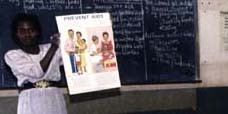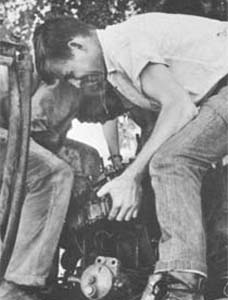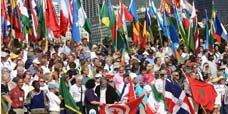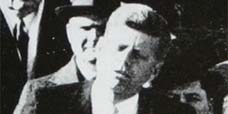
Bob and Pat Parish returned last October, forty years after being married in the capital of Addis Ababa at the end of our two years of Peace Corps teaching
Ethiopia
Jan 1, 2005
Colostomate Bob Parish is the president of the Hemet/San Jacinto UOA Chapter in California and his wife, Pat, is the treasurer. They journeyed to Africa to deliver ostomy supplies for the Friends of Ostomates Worldwide charity and were surprised and delighted by what they saw.
Ethiopia, East Africa, is the only country on that continent that traces its complete history through Biblical times. Often referred to as "The land of the Queen of Sheba," Ethiopia claims relationship to King Solomon, the son of David in the Old Testament of the Bible. According to Ethiopian tradition, the beautiful queen was seduced by Solomon when she went to seek his wisdom. Upon returning to Ethiopia, she gave birth to their son. The king, who had been smitten by Sheba, gave the treasured Hebrew Ark of the Covenant to the son Sheba bore to him. Most Ethiopians believe that that same Ark resides in the city of Axum today.
(No wonder Indiana Jones had trouble with the Eost Ark!!) To further verify their claim to Solomon and Sheba, Ethiopians point to the Falasha tribe, sometimes called "The Black Jews of Africa," which still holds closely to many Jewish traditions.
Top left: Bob and Pat Parish at Desta Mendir with head mistress and urostomates. Left: Stoma Therapist Ruth Cadissa. Top: Dr. Frehiwot giving Pat Parish a traditional dress.
Ethiopians also proudly point out that Christianity was brought to them by the Ethiopian eunuch, who, in the book of Acts in the New Testament, had the apostle, Phillip, interpret a portion of Isaiah. The eunuch asked to be baptized, and, as a leader of the Ethiopian royal court, brought Christianity to their country.
To this historical mountainous country, split in half by the Great Rift Valley which forms numerous great canyons and high plateaus of 7,000 - 12,000 feet, Bob and I returned last October, forty years after being married in the capital of Addis Ababa at the end of our two years of Peace Corps teaching. We had met in the town of Dessie, 200 miles north of the capital. Pat was then Miss Summers to her Ethiopian students, who in turn called her "Tsahainesh," which meant, "You are Sunshine." Bob was Mr. Parish or "Nitchras" which meant "white hair" (for his sun-bleached blond hair) or "wise one" since white hair came with age and thus, wisdom in the thinking of his students.
Forty years ago, we celebrated our marriage by visiting Emperor Haile Selassie's palace zoo. This time, we were returning for a much different purpose.
Being retired teachers, we frequently spend vacations volunteering on various projects in the U.S. and around the world, Mescalero Apache Indian Reservations, Baja California, Yucatan Peninsula, Soviet Union, etc. This all come to a halt in 1999 when Bob was diagnosed with colorectal cancer! After twenty-seven surgeries, two months of radiation and six months of chemotherapy which put Bob on a permanent colostomy, we thought the life of volunteer work in unusual places in the world was over.
However, three years into his colostomy, Bob decided he was strong enough to try a project in Peru with Medical Ministry International. This first venture into foreign travel with an ostomy was such a success that we decided to try another undertaking. Plans to return to Peru the summer of 2004 were underway when Bob was elected president of the Hemet/San Jacinto Chapter of UOA. The Louisville, Kentucky conference was going to occur at the same time as the Peru trip. Although we were pleased to attend the conference, there were elements of sadness in missing out on Peru. However, at the conference, we heard about Friends of Ostomates Worldwide (P.O.W.) and ostomy materials that had been sent to Ethiopia.
We thought how wonderful it would be to accompany those supplies one day.
When friends returned from Peru, they told us to get online regarding another MMI trip in January. As Bob scanned down the MMI Projects, an eye clinic in Ethiopia popped up. It was scheduled for October 9-23, only five weeks away! Immediate e-mails were sent to MMI. On August 31 came the message to "Join us for the first MMI Project to Ethiopia." Unlike the previous MMI trip of fifty plus volunteers, there would be only five of us, including Bob and myself.
Needless-to-say, a hectic five weeks ensued with decisions to be made on the length of this trip. We knew we would need about a month. How were we going to pay for the trip? How does one pack for a month on the other side of the world, especially since MMI was sending us tubs and tubs of medical supplies to carry in addition to our belongings! There were shots, visas, ostomy supplies to obtain for a month. Who would care for our dalmatian? We needed to establish contact with F.O.W. and obtain information on the hospitals and/or other recipients of ostomy supplies in Ethiopia. We heard that many of our former students were killed or put into prison during the communist take-over.
Could we find any of them still alive?
Pieces of this complex arrangement kept falling into place. Bob's Idyllwild Rotary Club, our Idyllwild Community Presbyterian Church and individuals supported us financially and with prayers. Online communication with Fred Moore and Joan Loyd at F.O.W. put us in touch with the Women's Fistula Hospital and the Black Lion Hospital in Addis. A former student offered to care for our dog. Everything fell into place and we were off to Ethiopia!
Upon completion of the two-week eye clinic in Soddo where we assisted with 100 cataract surgeries and distributed 700 reading glasses, we returned to Addis, the capitol, and contacted the Women's Fistula Hospital. After three phone calls to Ruth C. Kennedy, the liaison coordinator for the hospital, we were contacted by Ruth Gadissa. Ruth came to the guesthouse where we were staying in Addis. This beautiful, thirty-year-old woman who had only two days of stomatherapy training in South Africa, is the only person trained to work with stomas in a country of 70 million!
Her job is an overwhelming task with hundreds of urostomates. Was she daunted? Not the least! Her lovely smile beamed with joy that God was able to use her in this special way with the thousands of girls who are forced to go through fistula surgery and the hundreds who result in urostomies.
Her first good news was that the pallet of supplies from F.O.W. had arrived with no problems from customs just a few weeks before our arrival. Her second good news was that everything could be used, however not at the fistula hospital. She had many things taken over to the Black Lion Hospital for their use. Ninety percent of the patients at the fistula hospital are urostomates!
What is a fistula? It is an abnormal passage from an internal organ to the body surface or to another organ. They can cause leakage, infections and even death. In Ethiopia, it most commonly occurs during prolonged labor in childbirth. It is the custom for girls to marry between 12 and 14 or before their first menstrual period. Thus, these young teenagers are frequently giving birth before their own pelvises have fully formed. The fetus is often much too big for an ordinary delivery. Girls are taught to squat and push the baby out. However, after two, three or four days of excruciating pain, the baby is not only dead, but the mother's bladder has ruptured in numerous places.
Sometimes the dead fetus is naturally expelled. However, the young wife's problems are just about to begin.
Urine seeps into the vaginal area and her husband is appalled and leaves her. She has no control over the leakage which can even include fecal matter. She smells horrendous. Her own family no longer wants her. If she doesn't die from infection, she dies from neglect. This goes on daily in thousands of grass huts throughout Ethiopia.
Only a fortunate few have family members who will put her on a pallet and carry her for three or more days up and down mountain pathways to a hospital that hopefully can perform the correct surgery to mend the young girl. There are projects going on to encourage later marriage for women, but customs held to for thousands of years are difficult to change.
Ruth Gadissa gave us a list of the urostomy materials needed, which we have passed on to F.O.W. Ruth also requested booklets that would show pictures of people wearing or putting on flanges and bags. Any video of such procedures would also be welcome since they have VHS access. Ruth profusely told us to thank F.O.VV. for all the creams, ointments, powders and belts. These girls are very small in size. Ruth helps them to measure their stomas and the templates for this are extremely helpful.
She gave us a "shopping list" of supplies needed. With her excellent English, she was apologetic for requesting so much, but emphasized how none of these supplies are available anywhere in the country.
Bob and I were taken to Desta Mendir, "City of Joy," by Ruth. This beautiful place, 17 kilometers from Addis on a high green plateau and surrounded by rolling green hills with beautiful white cottages, has become home for many of the girls with urostomies who can no longer return to their families. Most of us cannot imagine the unsanitary conditions most of the young girls have lived in.
Few have experienced running water or electricity in their grass and mud homes. One simply finds a spot of dirt somewhere behind their grass house to relieve themselves. Water is often car\ried from a river down a series of narrow mountain paths and then back up rocky, dirt paths. This water is only used for drinking and cooking. Clothing is infrequently washed in the river, where one also infrequently bathes. Desta Mendir has become a pristine place of serenity and refuge for its inhabitants.
Here, Ruth holds meetings with the girls to help them with their supplies. She has been trying to show some of them how to use night bags for their urostomies, but many are still uncomfortable with this. They'd rather wake each other up to go to the bathroom which to them is amazingly located in a special room in their cottage, along with shower stalls! The girls all are in literacy classes, both English and Amharic, the Ethiopian language spoken most widely in the country. Only six percent of females in Ethiopia are literate! The girls also are learning math, crafts, gardening, cooking skills and many practical endeavors.
We are attempting to send teaching materials to Desta Mendir through the fistula hospital.
During our visit, we were invited to have a lunch that the girls had prepared. Injerra, a two-foot diameter gray, pancake-like bread and wat, a hot-spicy stew, makes up the typical food. No utensils are used. One pulls off a bit of the injerra and dips it in the stew, picking up pieces of vegetable or meat. The girls also put on a special coffee ceremony for us. Ethiopians pride themselves with the coffee grown there. In fact, they point to the province of Kaffa where the name for "coffee" originated.
Desta Mendir has a nurse/housemother who lives on the compound. She also distributes ostomy supplies to the young women as well as other necessary medicines. She is much loved by everyone and was appointed by Dr. Catherine Hamlin, the woman who started the fistula hospital, to oversee Desta Mendir. This elderly lady has written most of the books used to train nurses throughout the whole country.
Two other teachers drive in from Addis each day to instruct the girls in crafts and in literacy. Bob shared his colostomy with the girls; they were amazed that a man has an ostomy! Ruth translated for Bob and explained that his was from cancer. The girls were amazed that one could travel from America with an ostomy! Even I became more amazed as I saw how well my husband managed his stoma. In some ways, I was even envious, especially when some toilets were only holes in the ground! A pouch was a lot easier to empty!
We were also amazed to find a plaque on one of the buildings showing contributions from Rotary International and one of the safe- water wells put onto the property by another Rotary group. It was very difficult to leave this lovely place of serenity and repose and the beautiful young girls learning to live with urostomies. With our limited Amharic, we learned that some of these girls want to become nurses like the beautiful young model-nurse, Ruth Gadissa, they were learning so much from.
Upon our return to Addis, Ruth took us on a tour of the Women's Fistula Hospital. This immaculate, sweet-smelling ward of dozens of beds filled with patients emanated caring and compassion. We saw Hollister boxes under many of the beds. This company certainly has been most generous with their supplies to Ethiopia. Dr. Hamlin and her husband, Rex, with the help of Empress Taitu, were instrumental in building this facility where over 37,000 fistula surgeries have been performed. Their son, Richard, appears to be carrying on the family tradition. We encourage everyone to read Dr. Hamlin's book, The Hospital by the River, A Story of Hope to understand better the plight of Ethiopian women.
Our sincere wish is to have Ruth Gadissa come to the U.S. for complete ET/WOCN training. Perhaps some of the readers of this article will be able to help provide a scholarship for her. Ruth Kennedy, liaison at the fistula hospital, called us on our last day in Ethiopia to make a request. They would take care of the airfare if only the training, lodging and food for her stay could be provided. People here would not just be helping this young woman, but all the ostomates of Ethiopia. How blessed we are to be Americans and to have so many valuable resources available to us!
We have so much more to share: the needs of the Dessie Regional and Referral Hospital which also does fistula and colostomy surgery; the number of smaller hospitals and clinics throughout the country; the cataract surgeries with which we assisted; the incredible work going on in the prisons throughout the country (these prisoners are, for the most part, political prisoners); discovering students and their children from over forty years ago; meeting Ethiopian doctors who see the needs of their own people and desire specific books for us to send; seeing the HIV/AIDS projects and the much needed orphan and refugee work going on throughout the country; the growth of the Kali Hiwot (Word of Life) and the Makane Yesus (Dwelling Place of Jesus) Churches throughout the country and their partnerships with World Vision for working on needs too numerous to mention here; the work with the hundreds of thousands of cases of elephantiasis, where people are shunned more than lepers, but could be helped if they only had shoes; etc, etc.
Each one of these is a story in itself!
Yes, my marvelous ostomate husband did heroically on this trip, sharing not only at Desta Mendir, but in a number of other situations. I'll conclude with an incident at the Dessie Hospital, where an overworked surgeon and director took us through a very rundown facility housing 210 patients and a dozen more on beds in the corridors. Dr. Misganaw took us to where a new colostomate lay. The man was frightened as the doctor pulled back the sheet and showed us the make-shift plastic bag attached with tape. Bob pulled his zipper slightly down to release a triangle of his jeans and pointed to his colostomy.
Taking the man's hand, Bob said, "God had been healing me of my cancer with this ostomy so I can come from the other side of the world and give you hope."
The new ostomate's frightened family nearby had tears running down their faces and the man stared at Bob with wide eyes. Over and over again, people came to us and grasped our hands, saying, "You cared enough to come. We can't thank you enough." What an incredible blessing these people were to us!
The Friends of Ostomates Worldwide-USA, Inc., is an IRS- approved, 501(C)(B), all volunteer-run organization which collects surplus, donated ostomy supplies for shipment to places of need throughout the world.
In all cases, the supplies are distributed to needy persons, free of charge, under the direction of a responsible person, knowledgeable in ostomy management, such as an ET nurse. FOW-USA relies on contributions from individuals and organizations to cover the costs of packing and shipping the supplies. Please send surplus supplies to:
FOW-USA Project SHARE
4304 Regency Drive
Glenview, IL 60025-5200
http://www.fowusa.org
Copyright United Ostomy Association Inc. Winter 2005










